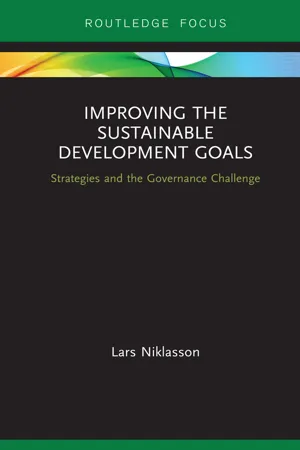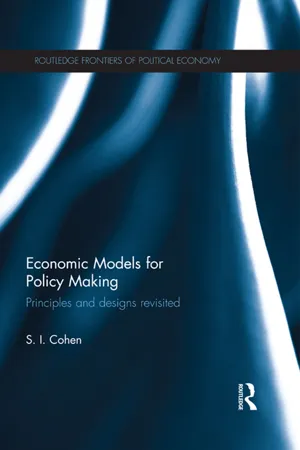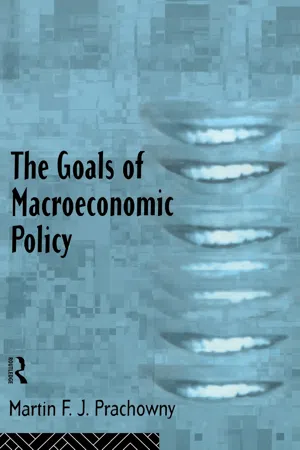Economics
Economic and Social Goals
Economic and social goals refer to the desired outcomes that a society aims to achieve through its economic policies and activities. Economic goals typically include factors such as economic growth, full employment, price stability, and efficient allocation of resources. Social goals encompass aspects like reducing poverty, promoting equality, improving living standards, and enhancing overall well-being within a society.
Written by Perlego with AI-assistance
Related key terms
6 Key excerpts on "Economic and Social Goals"
- eBook - ePub
Improving the Sustainable Development Goals
Strategies and the Governance Challenge
- Lars Niklasson(Author)
- 2019(Publication Date)
- Routledge(Publisher)
These goals are more focussed on ends than on means, especially in comparison to the goals on the economic dimension. This means that they state a number of concerns but add only a little in terms of how to achieve them. Some examples of means are food production and government planning. This, in turn, makes it reasonable to think of the economic goals as means to achieve the social goals. A main problem is to find the financial means to pay for social services and basic investments. At the same time, the social goals include means to achieve some of the economic goals – for example, in the form of education and skills development (“human capital”) needed for advanced production.Economic growth is a way to create resources which can be used to pay for education and health care, etc. Several goals talk about resource mobilization, but the more specific issue of domestic taxes is almost not addressed at all. It is most explicitly stated in goal 17 (below).The environmental dimensionThere are four goals which relate to traditional environmental concerns: goals 12–15. There are links from some of the other goals to environmental issues, as indicated earlier. I will come back to how these goals relate to the Economic and Social Goals, if the environmental goals are limits on the others and if the others contribute to or hinder the fulfilment of the environmental goals.Goal 12: responsible production and consumptionThe aim of goal 12 is to “ensure sustainable consumption and production patterns”. It is a bridge between the economic and environmental issues. It formulates key aspects of sustainable development by placing limitations on consumption and production, which are the two fundamental dimensions of the economy.Target 12.1 states the general goal of working with these issues and asks the developed countries to take the lead, “taking into account the development and capabilities of developing countries”. Target 12.2 specifies what this should lead to – i.e. to “achieve the sustainable management and efficient use of natural resources”.The following targets add goals on waste management (target 12.3), waste generation (target 12.5) and a concern with “environmentally sound management of chemicals and all wastes” (target 12.4). Target 12.6 relates to businesses and target 12.7 to public procurement. - eBook - ePub
- Solomon Cohen(Author)
- 2013(Publication Date)
- Routledge(Publisher)
4Social Economic Development Goals in Economy-Wide Policy Models An Application to Korea 1 BackgroundIn the early decades of development economics, mainly in the fifties and sixties, economic development was analysed and planned in terms of economic growth. The central development objective was the growth of GDP, and sometimes GDP per capita. Empirical data on the actual performances in most developing countries gave a different picture, showing increasing income inequalities, more population groups falling behind poverty lines, increasing underemployment and unemployment, and deteriorating food and other living conditions. The new picture brought a revision in interests and insights by economists and planners dealing with development problems. One of the reactions that emerged was the social economic development perspective, which saw the misplaced focus on GDP as the fault in the planning framework, and they went for reformulating development models and plans in terms of broader social economic development goals.In spite of the accelerated interest in a social economic development perspective there were no attempts made to put up an operational framework that would unify new goals in the development planning models that were commonly used at the time. There was a flood of definitions and concepts on basic needs, social indicators, social aims, and so on, but most of them were dispersed and not accessible in economic models. Our contribution in this area was to broaden the scope of policy modelling and planning practices towards the social economic development perspective. This chapter formulates and applies a social economic development model that supplements GDP growth with income and employment variables belonging to social groups, and indictors on attainment of wellbeing, and it extends the scope of policy instruments and other relationships accordingly. Primarily for reasons of data availability, the Republic of Korea was selected as a test case. The model was estimated on the basis of data for the sixties and was employed to simulate development up to the early eighties. Interestingly, the empirical applications around 1970 showed positive and coherent future performances for Korea on its GDP, distribution, employment, and basic needs attainment for the seventies and early eighties; these outcomes were also confirmed by the realised development performance of Korea years later. - eBook - ePub
- Neva Goodwin, Jonathan M. Harris, Julie A. Nelson, Pratistha Joshi Rajkarnikar, Brian Roach, Mariano Torras(Authors)
- 2018(Publication Date)
- Routledge(Publisher)
Here we cannot avoid some normative judgments, as people may disagree about what constitutes well-being. But we can identify some general goals that are widely accepted as desirable. In Table 1.1, we present one possible list of the final goals of economic activity, summarizing the reflection of a number of thinkers but not attempting to represent a final consensus. The first five goals on the list are primarily individual concerns while the last five are more related to social concerns. Some of the goals involve making life possible, some involve making life worthwhile, and yet others involve both types of goals - eBook - ePub
The Agrarian Vision
Sustainability and Environmental Ethics
- Paul B. Thompson(Author)
- 0(Publication Date)
- The University Press of Kentucky(Publisher)
Neoclassical economic theory provides a model of producers and consumers interlinked through laws of supply and demand. Supply and demand operate through a market. The abstract idea of an economic market is a generalization of what happens in real markets that still exist in many parts of the world. Local farmers congregate in a central location, displaying their wares. Buyers—both consumers and merchants—examine the offerings, tendering money for lots of beans, peas, melons, meat, eggs, or fish, sometimes talking the seller down from the original asking price. The market for corn that exists in industrialized nations is an amalgam of technology (railcars, elevators) and institutions (grading mechanisms, the Chicago Board of Trade), but it still allows producers to seek buyers for their goods. As individual producers determine what things to offer and buyers budget their resources to discipline their desires, the market—the invisible hand—guides the final outcome by establishing prices that reflect the willingness of all parties to make an exchange. Markets perform this aggregation function more or less effectively, depending on a host of factors, but my purpose here is not to offer a thoroughly realistic or critical treatment of economic exchange. My point is this: because neoclassical economic theory yields a set of standards by which we can judge how well this system is operating, it provides a basis for identifying social goals for the system's performance. As Adam Smith noted, these are not the same goals that bring individual buyers and sellers to the market. Individuals may not have any preferences in terms of how they would like to see the market perform; nonetheless, their ability to satisfy their conscious goals can be materially affected by the way the market does perform.Neoclassical theory can be extended in ways that specify a large number of social goals. Economists generally shy away from actually advocating these goals. The point of their analysis as they understand it is simply to point out the consequences of organizing a market system in one way rather than another. Two goals that are easy to bring into a discussion of ethics can also be described in fairly nontechnical terms, but unlike my economist friends, I do not demur to the use of “shoulds” and “oughts” in describing them. When functioning properly, the market should assure that the things people want and need to live are available because there are economic incentives for producers to supply them. We can call this the productivity goal of the neoclassical model. Second and correlatively, markets should direct investment toward the mixture of enterprises that best satisfies the aggregated demands of consumers. This is the efficiency goal of markets. I admit that my terminology is loose, but the terms productivity and efficiency are so badly abused in contemporary usage that there can be little harm in abusing them a little more here.Agricultural productivity is a social goal for an industrialized society because people need the food and fiber commodities that agriculture produces, and because industrial societies are organized so that the majority of people are in no position to produce food and fiber goods for themselves. Although all of us want to eat, no one in an industrial society needs to set food production as a personal goal to accomplish this end. This is true even for farmers, who may buy all the food they eat from the local grocery, just as I do. Farmers and ranchers may produce food and fiber because they feel a moral duty to prevent starvation or because they hope to sell it for a profit. For my part, I may walk down to the delicatessen and buy an olive-pimento cream cheese bagel because I want to put some money in the pockets of farmers, about whom I care deeply, or simply because I'm hungry. In the market system, it makes little difference what the intentions of individual buyers and sellers might be. The social goal of productivity depends on how well all these exchanges are coordinated through the market mechanism. - eBook - ePub
- Martin Prachowny(Author)
- 2012(Publication Date)
- Routledge(Publisher)
1 The Theory of Macroeconomic GoalsDespite the genesis of macroeconomic theory as a scientific response to the Great Depression, very little effort has been directed since then toward the specification of precise goals for macroeconomic policy and toward the analytical basis for these goals. Defining and justifying macroeconomic goals is still shrouded in such amorphous terms as “full employment” and “price stability”. Much of macroeconomic analysis has instead been devoted to arguing about the ability or inability of macroeconomic tools, such as fiscal and monetary policies, to influence macroeconomic performance towards exogenously chosen goals, without questioning the arbitrariness of these goals. This state of affairs seems to be tolerated even though there has been a prolonged pre-occupation in microeconomics with the evaluation of policies in terms of Pareto improvements, where at least one person is better off but no one is made worse off.1.1 The Pareto Optimality of Macroeconomic GoalsTo set the stage for the remainder of this chapter, contrast the inattention to optimality in macroeconomic-policy discussions with the rigorous approach on this issue prevailing in other areas, such as international trade theory and policy. The long tradition of debating the merits of free trade and the intellectual acceptance of the “optimum” tariff have been shaped by the clearly specified goal of maximizing a social welfare function. The difficulties in translating such abstract concepts into concrete actions are not to be minimized and less-than-optimal trade policies continue to be implemented by governments certain that they can justify their actions on the basis of some economic reasoning. Nevertheless, academic trade economists understand instinctively that policy intervention must be based on a clearly defined Pareto welfare improvement.1 - eBook - ePub
- United Nations Department of Public Information(Author)
- 2017(Publication Date)
- United Nations(Publisher)
Chapter IIIECONOMIC AND SOCIAL DEVELOPMENT
Ahead of the United Nations Sustainable Development Summit from 25–27 September, a 10-minute film introducing the SDGs was projected onto two of the façades at UN Headquarters, bringing to life each of the 17 goals to raise awareness about the 2030 Agenda for Sustainable Development (22 September 2015, UN Photo/Cia Park).M any people associate the United Nations with the issues of peace and security, but most of the Organization’s resources are devoted to advancing the pledge of its Charter to “promote higher standards of living, full employment, and conditions of economic and social progress and development”. UN development efforts have profoundly affected the lives and well-being of millions of people throughout the world. These endeavours are guided by the conviction that lasting international peace and security are possible only if the economic and social well-being of people everywhere is assured.Many of the economic and social transformations that have taken place since 1945 have been significantly affected in their direction and shape by the work of the United Nations. As the global centre for consensus-building, the UN has set priorities and goals for international cooperation to assist countries in their development efforts and to foster a supportive global economic environment. The United Nations provides a platform for formulating and promoting new objectives on the development agenda through international conferences, including the need to incorporate specific issues such as the advancement of women, human rights and good governance into the development paradigm. Over the years, the world view of development has changed. Today, countries agree that sustainable development—development that promotes prosperity and economic opportunity, greater social well-being, and protection of the environment—offers the best path forward for improving the lives of people everywhere.
Learn about this page
Index pages curate the most relevant extracts from our library of academic textbooks. They’ve been created using an in-house natural language model (NLM), each adding context and meaning to key research topics.





